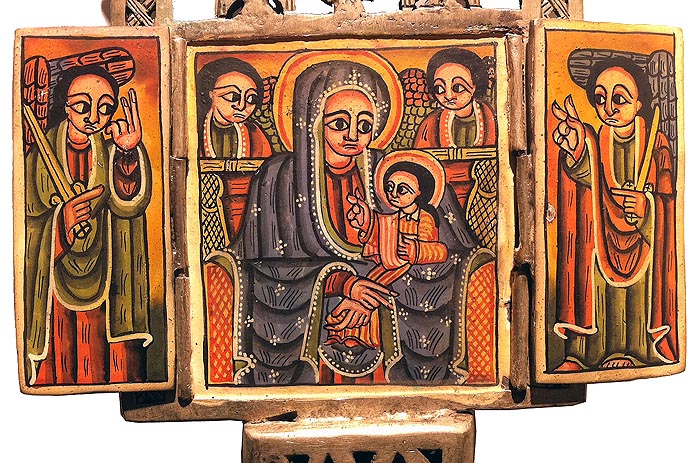Prehistorically,
rock art was the most common form of art, and it was similar in fashion to
other specimens from other regions in this part of the world. After Christianity was adopted, much of
the artwork was religious-themed.
Iconography was common, characterizing the figures with their bright
colors and almond-shaped eyes.
Diptychs (panel paintings with two panels) and triptychs (panel
paintings with three panels) were also common. The churches and cathedrals themselves were fully painted in
the European tradition. There were
some minor differences; for example, angels were often depicted as being heads
with wings.
Crosses
were very important as well. Many
of these are highly elaborate and ornate.
These crosses were mostly constructed from brass and plated with either
gold or silver. Crosses used in
processions could be quite large in size and quite heavy. Smaller crosses used as jewelry were
also made and worn. Other
metalwork, such as crowns, was made for both royalty and high clergy
members.
Textile
art was also commonly produced in Ethiopia. A type of lightweight, opaque pattern-less cloth similar to
chiffon was used to drape onto religious icons. Generally, traditional cloth designs have geometric patterns
to them (although many are plain) and tend to be quite colorful.
Basket
making is quite common, especially in the rural areas of Ethiopia. Depending on its use, whether for storing
food, doubling as tables, or being used as bowls, baskets can range from small
to quite large. Designs are woven into the baskets as well.
Early
Ethiopian literature was written in the Ge’ez language. The Bible and other
religious writings dominated the early literature canon. The Ethiopian Orthodox
Tewahedo Church still uses the Ge’ez language as the language of religious
literature. The Ethiopian Jewish
community (also known as Beta Israel) still uses the Ge’ez language today as
well. The Garima Gospels are the oldest Ge’ez scripts, found in Eritrea and
thought to date somewhere between 390-660.
By
the time the 14th century came, the language of literature was
starting to shift towards using Amharic, Tigrinya, and Tigre, depending on the
location. Histories, hagiographies, and letters have been found that have been
dated during these early years through the 16th century. Works such
as “Book of Axum” and “Book of Enoch” are two famous works written in Ge’ez.
 |
| Book of Enoch |
Literature
written in Amharic covers more works in the most recent centuries. Although it
also includes religious materials, it also includes educational materials,
government records, novels, poetry, and basically anything that is read
today. Because of their
multi-lingual society, the government declared the Amharic as the official
working language of the federal government. It’s also the language of primary education. Other regional languages may be used
locally and for unofficial business.
Up
next: music and dance






No comments:
Post a Comment